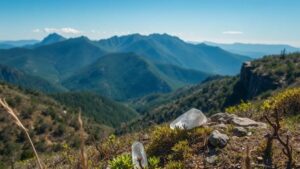Crystals in the Clouds: Unearthing High-Altitude Treasures in Glacial Deposits
Crystals in the Clouds: Unearthing High-Altitude Treasures in Glacial Deposits
Crystals formed through geological processes are some of natures most exquisite treasures. For rockhounds and mineral collectors, high-altitude regions, especially those with glacial deposits, are particularly promising. These areas not only harbor a diverse array of minerals but also serve as a unique opportunity to uncover crystalline formations that have remained hidden beneath layers of ice and rock for millennia.
The Formation of Glacial Deposits
Glacial deposits, also known as till, are the result of the grinding action of glaciers as they flow over bedrock, transporting a mixture of sediments and minerals. e deposits can often contain well-preserved crystals and minerals that are difficult to find in other environments. The combination of extreme cold and pressure creates a unique setting for mineral crystallization.
Some key factors that contribute to crystal formation in glacial environments include:
- Temperature: Low temperatures favor the stability of certain minerals, impeding their weathering.
- Pressure: Glacial movements exert significant pressure, converting amorphous materials into crystalline forms.
- Water Flow: Meltwater from glaciers can transport minerals, facilitating crystallization in favorable conditions.
Notable Minerals Found in Glacial Deposits
High-altitude glacial deposits are rich with a variety of minerals and crystals. Some notable examples include:
- Quartz: Often found in numerous forms such as amethyst and smoky quartz, these crystals can be remarkably clear and well-formed.
- Fluorite: Known for its vibrant colors, fluorite can often be found in glacial regions where it has been deposited from hydrothermal fluids.
- Calcite: Commonly occurring in stalactitic shapes, calcite is frequently found alongside older sedimentary deposits within glacial till.
- Topaz: This gemstone can be discovered in alpine zones, often exhibiting beautiful hues and excellent clarity.
The Science Behind Crystal Hunting
For collectors, understanding the science behind mineral formation can enhance the quest for high-altitude crystals. conditions conducive to crystallization require both time and specific environmental factors. For example, the age of glacial deposits can provide clues to the mineral composition. Researchers have found that sediment dated at roughly 10,000 to 20,000 years can contain some of the most pristine crystalline specimens.
When looking for these precious crystals, the following geological features can be important indicators:
- Moraines: These landforms consist of accumulated glacial debris, often serving as rich sites for crystal hunting.
- Outwash Plains: Formed by meltwater rivers, these areas can carry crystals and minerals deposited from the glaciers.
- Frost Fractures: These cracks in rocks can reveal hidden crystals when they are exposed to the elements.
Practical Tips for Collectors
Successfully locating and extracting crystals from high-altitude glacial deposits requires both knowledge and preparation. Here are some practical tips for aspiring rockhounds:
- Research Locations: Investigate known mineral-rich areas, such as the Canadian Rockies or the Alps, to find potential hunting grounds.
- Use Proper Tools: Equip yourself with tools such as a geologists hammer, chisels, and a sturdy backpack for transport.
- Pay Attention to Weather: Mountain weather can change rapidly. Ensure you have proper gear to stay safe and comfortable.
- Follow Environmental Guidelines: Respect nature by adhering to collecting regulations and minimizing your impact on the environment.
Real-World Applications and Examples
The significance of collecting crystals goes beyond mere aesthetics. Crystals from glacial deposits can serve multiple functions:
- Educational Tools: They are often used in geology classes to illustrate concepts of mineral formation and crystallography.
- Jewelry and Art: Unique crystals can be transformed into stunning pieces of jewelry or artistic displays, showcasing the beauty of nature.
- Research Specimens: Universities often seek samples from collectors for studies related to geology, climate change, and Earths history.
Conclusion
High-altitude glacial deposits offer rockhounds and mineral collectors a captivating glimpse into the Earths geological processes. With an understanding of mineral formation, appropriate tools, and responsible collection practices, enthusiasts can discover remarkable crystals that have been untouched for thousands of years. As you embark on your crystal-hunting adventures, remember that each specimen tells a unique story of Earth’s past and the forces that shaped it.



